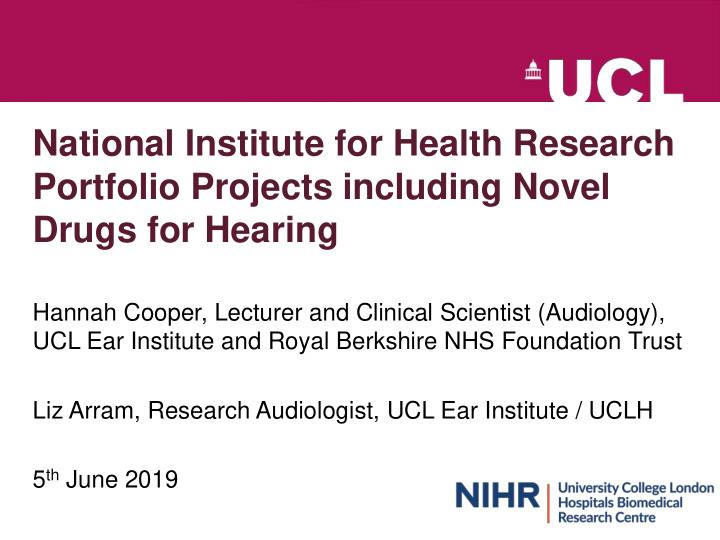



National Institute for Health Research Portfolio Projects including Novel Drugs for Hearing Hannah Cooper, Lecturer and Clinical Scientist (Audiology), UCL Ear Institute and Royal Berkshire NHS Foundation Trust Liz Arram, Research Audiologist, UCL Ear Institute / UCLH 5 th June 2019
Develop and deliver targeted and transformative therapies for patients with deafness and hearing problems Protect - Repair - Restore
Collaborations with industry • World class translational hearing research expertise and infrastructure - expertise from bench to bedside
• Ultimate goal to collect big data to build a platform informing public health policies related to hearing loss
• Strong focus on treatment of hearing loss: – Prediction of hearing aid use and outcome – Prediction of threshold shifts after noise exposure – Prediction of cognitive decline – Hearing aids with personalised settings – Hearing aid self-management options – Prototype auditory training mobile application (based on Loo et al. 2015 Ear Hear)
Assessing hearing devices with a multi speaker test: Development of a Spatial Speech Test • Testing word discrimination and relative localisation simultaneously, in the presence of multi talker babble • Q: Can this test be used to refine the hearing aid fitting?
Assessing hearing devices with a multi speaker test
• REgeneration of inner ear hair cells with GAmma-secretase INhibitors • The REGAIN project aims to develop and test a new drug administered to the ear to treat hearing loss caused by the loss of sensory hair cells in the inner ear.
Partners
Gamma Secretase Inhibitors • Small molecule pharmaceutical drug • Inhibits Notch, a trans-membrane receptor • Developed for and tested systemically in Alzheimer disease • Repurposed for topical use in sensorineural hearing loss
• In adult mice with noise induced hearing loss GSI promotes supporting cells to transdifferentiate into hair cells by blocking the Notch cell-to-cell signalling process, and partially restores hearing before after before after
Clinical Trial Progression
Trial Design • Phase I trial – first-in-man safety study in 15 patients (UK only) – Outcome: identification of highest safe dose 15 patients How safe is it? Phase I
Trial Design • Phase II trial – efficacy study in 40 patients (UK, Greece, Germany) – Primary outcome: hearing change at 3 months 40 patients Does it work? Phase II
Participants inclusion criteria Adults (m/f, 18 - 80 years of age) Mild to moderate bilateral sensorineural hearing loss Hearing loss of less than 20 years duration Using hearing aids or previously offered X Tinnitus as a primary complaint X Any significant co-morbidities
Week 1 Week 2 Week 3 Phase I + II Day 15 Day 8 Day 1 • Follow Up – Safety/Efficacy • Local and systemic adverse events • Changes in hearing, tinnitus – PTA, speech-in-noise, OAEs and patient reported measures • Changes in balance - history, examination and patient reported measures • Changes in facial nerve function/taste - patient reported measures
Study schedule – phase I Up to 28 days before treatment
Phase I study results • Positive results • Dose escalation demonstrated that trans-tympanic injection (3 administrations, one week apart) at the highest dose of 250 micrograms was safe and well tolerated • No safety issues were reported.
Study schedule – phase II Up to 28 days before treatment
Phase II • Open and recruiting • Results anticipated in 2020
Recommend
More recommend